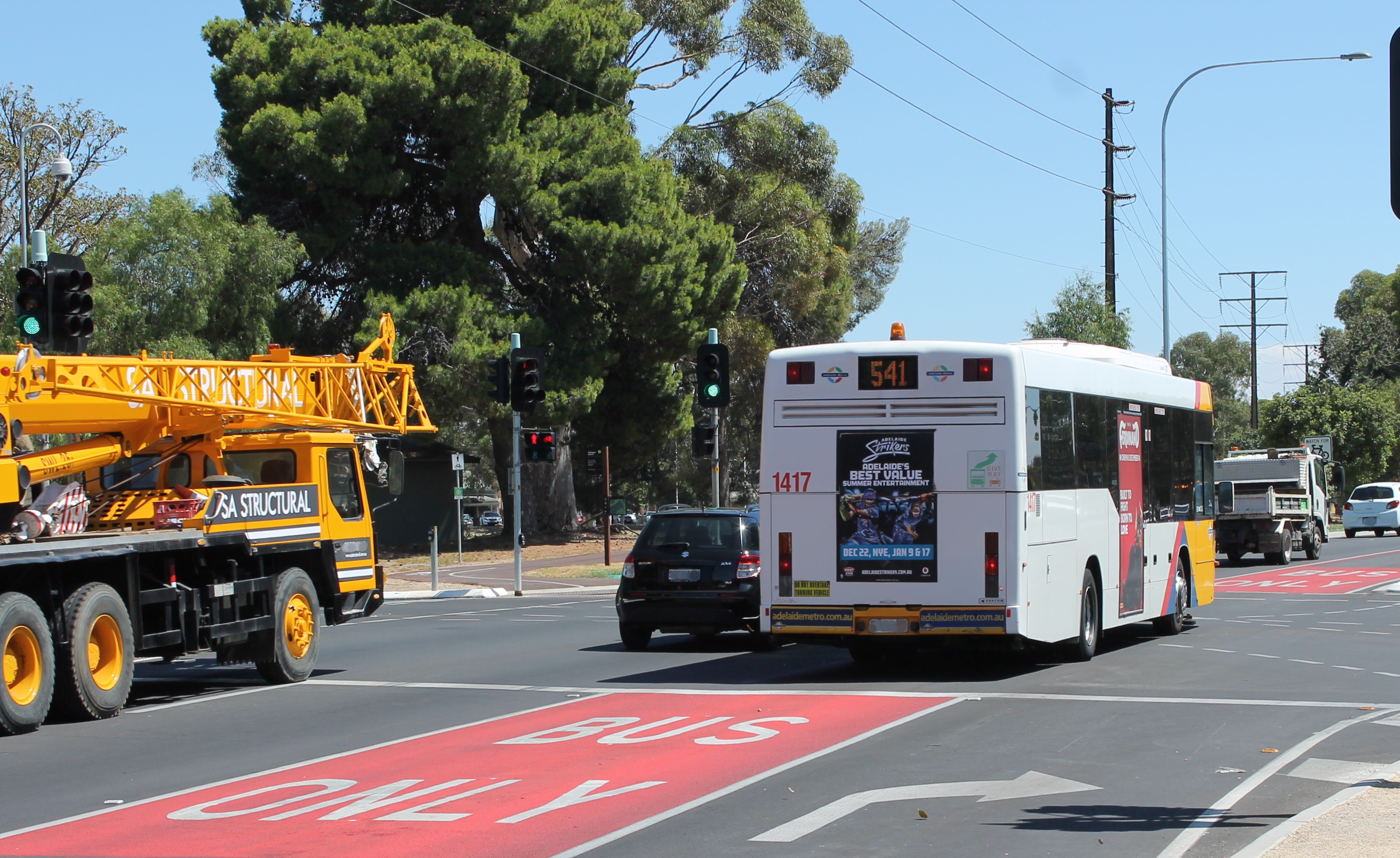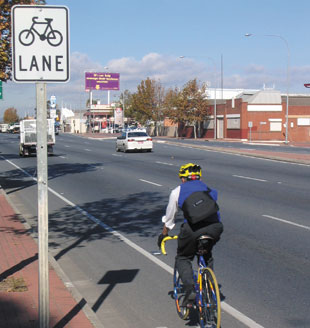The Driver's Handbook
Lanes

When driving on a road marked with lane lines, you must keep your vehicle entirely within a lane. It is an offence to straddle a lane line except when passing a bicycle rider to give them the required room.
Changing lanes
When changing from one lane to another you must:
- only change lanes when it is safe to do so
- give way to any vehicle travelling in the other lane in the same direction
- give a change of direction signal, giving sufficient warning to other road users before changing lanes.
If you need to change lanes in order to turn left or right, or for any other purpose, change lanes well in advance to give yourself ample opportunity to turn with safety. see Giving Way when Changing Lanes
Continuous lane lines
On a multi-lane road, you must not cross or drive on a continuous white lane line, except to avoid an obstruction, or, to allow the required room to safely overtake a bicycle rider. This does not apply to the lines separating bus lanes or bicycle lanes, or the lines separating a road from a road-related area such as a parking bay.
Bus lanes
A bus lane is a lane denoted by signs, which is for the exclusive use of buses, emergency vehicles, bicycle riders and taxi drivers during the times stated in the signs.
If there are no times stated it applies at all times.
While the bus lane is in operation, you must not:
- park or stop a vehicle, other than a bus, in a bus lane
- drive in a bus lane, except when:
- entering or leaving a road (e.g. another road, private property, parking area)
- overtaking a vehicle turning right or making a U-turn from the centre of a road
- avoiding an obstruction.
In each case the maximum distance you may drive in the bus lane is 100 metres.
Only public buses or emergency vehicles can use a "Bus Only" lane.
Bus Only Lanes are painted red, or marked with red lane lines, and have "Bus Only" in white letters.
Heavy penalties can apply to non-authorised vehicles travelling in Bus Only Lanes.
Bus Only Lane
Bus Only lanes start with the road painted with a red box with the words "Bus Only" in white. This is repeated every 200 metres. Between the red "Bus Only" boxes a "Bus Only" lane will be shown as a continuous red line alongside the white lane line marking.
Only a public bus, or emergency vehicle can travel in a Bus Only Lane.
The Bus Only Lane document (PDF, 2.2 MB) has more information about Bus Only Lanes.

Bicycle lanes

A bicycle lane is a lane indicated by a bicycle lane sign and lane line for the exclusive use of bicycle riders during the times stated on the signs. If there are no times stated, it applies at all times. Bicycle Lanes may be coloured green where there is a greater potential for conflict between motor vehicles and bicycles.
While the bicycle lane is in operation, you must not:
- park or stop a vehicle in a bicycle lane
- drive a vehicle (including a motorcycle) in a bicycle lane, except when:
- entering or leaving the road from private property, a parking area or another road
- overtaking a vehicle turning right or making a U-turn from the centre of a road
- avoiding an obstruction.
In each case the maximum distance you may drive in the bicycle lane is 50 metres providing you indicate and give way to bicycle riders.
Edge lines
You may only cross a continuous edge line including a line that separates where vehicles park when:
- turning at an intersection
- entering or leaving a road
- entering a part of a road of one kind from a part of a road of another kind, for example, moving into an emergency stopping lane
- overtaking a vehicle that is turning right
- driving a slow moving vehicle
- stopping at the side of the road
- driving a vehicle that is too wide or too long to drive without driving on or over the edge line
- The maximum distance you may drive across an edge line to enter or leave or overtake on the left of a vehicle intending to turn right is 100 metres.
Reversing
- You must not reverse unless it is safe to do so.
- You must not reverse any further than necessary.
When you reverse:
- always drive slowly and carefully
- always check in all directions before starting to reverse, particularly behind your vehicle. If necessary, get out and walk to the rear to ensure there is no obstruction or danger not visible from the driver's seat e.g. a child
- do not start reversing if there are pedestrians behind your vehicle or about to walk behind it. If necessary, sound your horn to warn pedestrians
- always look in the direction you are intending to reverse before beginning to move and continue looking in that direction while reversing, with occasional brief checks in all other directions. Use direct vision whenever possible - only use mirrors when direct vision is not possible.
Driving on footpaths
You must not ride or drive on a footpath except to enter or leave, by the shortest practicable route, adjacent property or a road-related area. When crossing a road-related area to enter or leave a road you must give way to any vehicle on the road, any pedestrian on the road and any other vehicle ahead of the driver's vehicle or approaching from the left or right. Watch out for bicycle riders riding on footpaths.
Driving on a traffic island
You cannot drive on a traffic island or median.
Driving on a median strip
You must drive to the left of a median strip unless you are entering or leaving a median strip parking area or you are required to drive to the right of the median strip by a keep right sign.
Driving on a dividing strip
You must not drive on a dividing strip except:
- to allow the required room to safely overtake a bicycle rider
- to avoid an obstruction
- to enter or leave a road
- to enter an area in the dividing strip where parking is permitted.
but only if it is safe to do so and you have a clear view of the road.
Driving on a painted island
You must not drive over a painted island however, you may drive on or over a single continuous line surrounding a painted island for up to 50 metres:
- to allow the required room to safely overtake a bicycle rider
- to enter or leave a road
- to enter a turning lane that begins at the end of the painted island.
- park in angle parking on the opposite side of the road
However, you must give way to any vehicle that is in the turning lane or entering the turning lane from the marked lane or line of traffic immediately to the left of the turning lane.
































